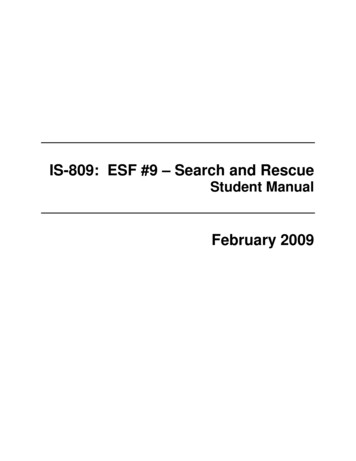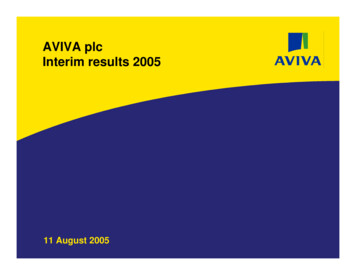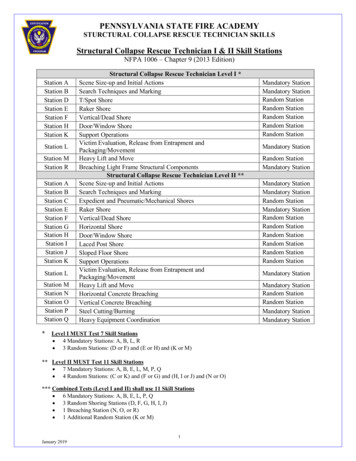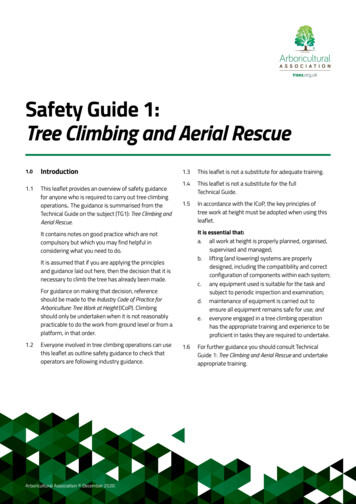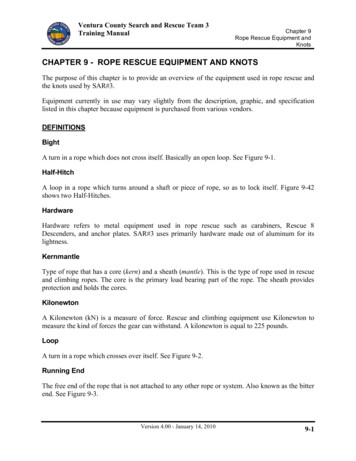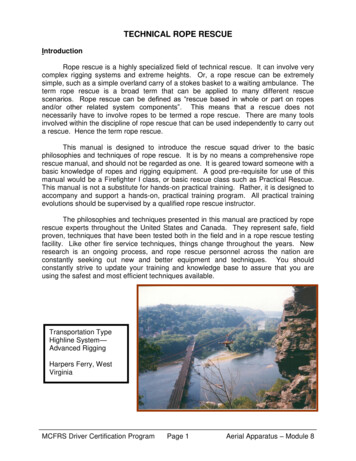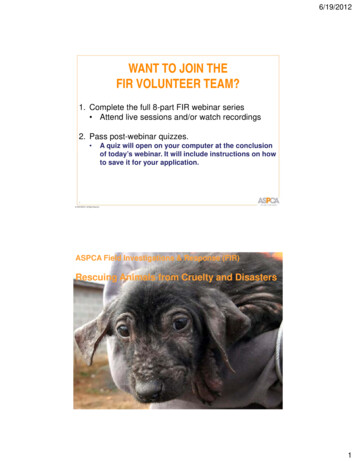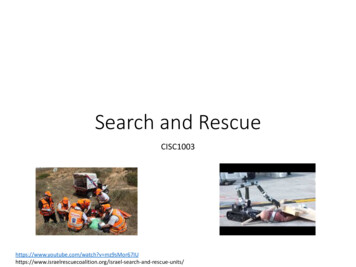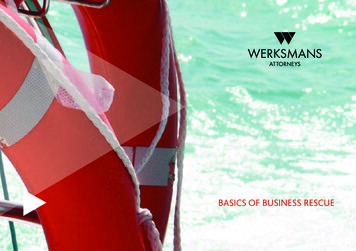
Transcription
BASICS OF BUSINESS RESCUE2
3
INTRODUCTIONRestructuring of companies in financial distress is on the increaseglobally. In line with this trend, Chapter 6 of the new Companies Act,No. 71 of 2008 (the Act) introduces business rescue to the South Africanbusiness landscape.South African companies that are financially distressed in South Africanow have an opportunity to reorganise and restructure. This has farreaching effects on creditors, financial institutions, shareholders,employees and restructuring specialists.This document highlights some of the Frequently Asked Questionsaround business rescue.1
1. What is business rescue?Business rescue proceedings are proceedingsaimed to facilitate the rehabilitation of a companythat is financially distressed by providing for – the temporary supervision of the company,and the management of its affairs, businessand property, by a business rescue practitioner; a temporary moratorium (stay) on the rightsof claimants against the company or in respectof property in its possession; and the development and implementation, ifapproved, of a business rescue plan to rescuethe company by restructuring its business,property, debt, affairs, other liabilities andequity (section 128(1)(b)).2. What is the aim of business rescue?The aim of business rescue is to restructurethe affairs of a company in such a way thateither maximises the likelihood of the companycontinuing in existence on a solvent basis orresults in a better return for the creditors of thecompany than would ordinarily result from theliquidation of the company (section 128(1)(b)(iii)).3. What is a business rescue practitioner?A business rescue practitioner is a personappointed, or two or more persons jointlyappointed, to oversee a company during businessrescue. While the Act defines a business rescuepractitioner as one or more persons, the business2rescue provisions of the Act do not necessarilyrefer to or support joint appointment. Further, theword “person” in the Act includes a juristic person.It is therefore arguable that a company can takeappointment as a business rescues practitioner(section 128(1)(d)).4. What is an affected person?Affected persons are important role players inthe business rescue process. An affected personis a shareholder, creditor, employee (or theirrepresentative) or a registered trade unionrepresenting employees of the company.Affected persons have various rights throughoutthe business rescue process (section 128(1)(a)).5. What is the test for business rescue?The test for whether or not a company should beplaced in business rescue is whether or not thecompany is financially distressed. TheAct defines the words “financially distressed”(section 128(1)(f)) to mean that – it appears to be reasonably unlikely thatthe company will be able to pay all of itsdebts as they become due and payablewithin the immediately ensuing six months(commercial insolvency); or it appears to be reasonably likely thatthe company will become insolvent within theimmediately ensuing six months(factual insolvency).
BUSINESS RESCUEPROCEEDINGS3
A company should commencebusiness rescue proceedingsat the first signs of it beingfinancially distressed, withinthe meaning of the Act.1. W hen should a company commencebusiness rescue?A company should commence business rescueproceedings at the first signs of it beingfinancially distressed, within the meaning ofthe Act. That is, either when it is reasonablyunlikely that a company will be able to pay itsdebts when they fall due for payment in theimmediately ensuing six months or when it islikely that the company will become insolventin the immediately ensuing six months.In a recent decision of the South GautengHigh Court, in the case of Welman v MarcelleProps 193 CC JDR 0408 (GST), the courtstated that “business rescue proceedingsare not for terminally ill close corporations.Nor are they for chronically ill. They are forailing corporations, which given time will berescued and become solvent”. This statementsupports the contention that at the first signsof financial distress, a company should applyfor business rescue. Once a company is morethan “financially distressed”, options otherthan business rescue become more attractivefor ailing companies, such as liquidations orcompromises.2. H ow is a company placed in businessrescue?There are two main ways in which a companycan be placed in business rescue, namely – when the board of directors of a companyresolves that the company voluntarily4commence business rescue proceedingsand be placed under the supervision of abusiness rescue practitioner (section 129 ofthe Act); and when an affected person makes a formalapplication to court for an order placingthe company under supervision andcommencing business rescue proceedings(section 131 of the Act), provided thecompany has not already been placed underbusiness rescue in terms of section 129, onthe basis that – the company is financially distressed; the company has failed to pay over anyamount in terms of an obligation underor in terms of a public regulation, orcontract, with respect to employmentrelated matters; or it is otherwise just an equitable to doso for financial reasons, and there isa reasonable prospect of rescuing thecompany.3. H ow does a company practicallyvoluntarily commence business rescueproceedings?The company must file Form CoR123.1 withthe Companies and Intellectual PropertyCommission (“CIPC”) and this must beaccompanied by the resolution of the board ofdirectors of the company (in which it resolvesto commence business rescue proceedings, andif it has a business rescue practitioner in mindat the time, to appoint a certain person as the
practitioner) together with a statement settingout the facts upon which the resolution wasfounded. Thereafter, the company must complywith a number of notice and publicationrequirements prescribed by the Act.4. W hat preliminary actions are requiredof a company that commencesvoluntary business rescue?In terms of section 129(3) & (4), once acompany has commenced business rescueproceedings, pursuant to the passing of aboard resolution in terms of section 129, thecompany must – within five business days of filing theForm CoR123.1, resolution and statement,with CIPC, publish notice of the resolution,together with a sworn statement asto the reasons why the company isfinancially distressed, detailing theprospects of rescuing the company, toall affected persons; andappoint a business rescue practitioner; after appointing a business rescuepractitioner, file a notice of the appointment of thebusiness rescue practitioner withintwo business days with CIPC; and publish a notice of the appointment ofthe business rescue practitioner withinfive business days after the notice isfiled.5. W hat happens if the time periods inrespect of voluntary business rescuesare not adhered to?With regard to voluntary business rescues,in terms of section 129(5)(a), if a companyfails to comply with the provisions of sections129(3) and (4), the resolution lapses and is anullity and the company may not file a furtherresolution for a period of three months afterthe date on which the resolution was adopted,unless a court, on good cause shown, approvesof the company filing a further resolution(section 129(5)(b).Further, an affected person can makeapplication to court in terms of section130(1)(a)(iii) to set aside the resolution onthe grounds that the company has failed tosatisfy the procedural requirements set outin section 129.6. H ow can one object or oppose abusiness rescue resolution?Section 130 provides that at anytime afterthe adoption of a business rescue resolution,an affected person may apply to court for anorder – setting aside the resolution on the groundsthat (i) there is no reasonable basis forbelieving that the company is financiallydistressed; (ii) there is no reasonableprospect for rescuing the company; or(iii) the company has failed to satisfy theprocedural requirements in section 129; setting aside the appointment of thepractitioner on the grounds that thepractitioner (i) does not satisfy therequirements of section 138; (ii) is notindependent of the company or itsmanagement; or (iii) lacks the necessaryskills, having regard to the company’scircumstances; or requiring the practitioner to providesecurity (in an amount and on termsand conditions that the court considersnecessary to secure the interests of thecompany and any affected person).A director of a company that votes in favourof a resolution may not apply to court to setaside the resolution or the appointment of thebusiness rescue practitioner unless such personcan satisfy the court that he acted in good faithon the basis of information that has since beenfound to be false or misleading (section 130(2)).Each affected person has a right to participatein a hearing contemplated by this section(section 130(47)).7. W hat goes into the papers for anapplication to court for businessrescue?The decision of the Western Cape High Court,Cape Town, in the case of Southern PalaceInvestments 265 (Pty) Ltd v Midnight StormInvestments 386 Ltd 2012 (2) SA423 (WCC) wasinstructive about the nature of the evidencethat must be placed before a court in order to5
ensure that an applicant indicates that there isa reasonable prospect that the company can berescued and to ensure that an application forbusiness rescue is successful.A business rescue plan that is likelyto merely prolong the agony of acompany by substituting one debtfor another without any glimmerof hope is not likely to suffice.6Judge Eloff dismissed the application forbusiness rescue. He held that “.it is difficultto conceive of a rescue plan that will have areasonable prospect of success of the companyconcerned continuing on a solvent basis unlessit addresses the cause of the demise or failureof the company’s business, and offers a remedytherefor that has a reasonable prospect of beingsustainable. A business plan which is unlikelyto achieve anything more than to prolong theagony. by substituting one debtor for anotherwithout there being light at the end of a not toolengthy tunnel, is unlikely to suffice”. The courtwent on to state that the applicant must dealwith “concrete and objectively ascertainabledetails in support of business rescue and whichfacts are beyond mere speculation”. These factsshould include “ the likely costs of rendering the companyable to commence with its intendedbusiness or to resume the conduct of its corebusiness”; the availability of “cash resources” to enablethe company to meet its daily expensesand the nature of the funding on which thecompany will rely;“ the availability of any other necessaryresources, such as raw materials and humancapital”; and“ the reasons why the proposed businessrescue plan will have a reasonable prospectof success”.The court went on to state that without suchdetails, a court is not only unable to considerthe prospects of the company continuing inexistence on a solvent basis but is also unableto consider the alternative aim of securing abetter return for the creditors of the companythan would arise from a liquidation.Similar sentiments were expressed by thecourts in the case of Koen & Another vWedgewood Village Golf & Country Estate (Pty)Ltd & Others 2012 (2) SA 378 (WCC), Swart vBeagles Run Investments 25 (Pty) Ltd & Others(four creditors intervening) 2011 (5) SA 422(GNP) and Kovacs Investments 571 (Pty) Ltd vInvestec Bank Ltd & Another (unreported case no25051/2011, 22 February 2012).The extent to which it is reasonably possible toinclude all the information that the court setsout in the case of Southern Palace Investments265 (Pty) Ltd v Midnight Storm Investments 386(Pty) Ltd in all business rescue applications is amatter that will need to be dealt with in timeby our courts.8. H ow does one oppose a business rescueapplication to court?Business rescue proceedings are generallylaunched on an urgent basis and thus the timeperiods ordinarily applicable to applications willgenerally not apply.
Any affected person on whom an applicationfor business rescue has been served, mayoppose such application in the manner in whichany other application is ordinarily opposedby serving and filing a notice of intention tooppose the application and thereafter servingan answering affidavit on the applicant inaccordance with the time periods set out in thenotice of motion.Any affected person opposing a business rescuemay either request the court to dismiss theapplication together with any other appropriateorder, including an order placing the companyunder liquidation.9. H ow long do business rescueproceedings last?Section 132 provides that business rescueproceedings should last for a period of threemonths. It is not clear what the words “businessrescue proceedings” intend to cover but it isunderstood that during the three months, thebusiness rescue practitioner must do his jobby convening meetings for affected persons,consulting on the the business rescue planand thereafter implementing the plan if it isapproved in accordance with the Act.If business rescue proceedings have not endedwithin three months after the start of thoseproceedings, or such longer time as the court,on application by the practitioner, may allow,the practitioner must – prepare a report on the progress of thebusiness rescue proceedings, and update itat the end of each subsequent month untilthe end of those proceedings; and deliver a report and each update in theprescribed manner to each affected personand to (i) the court (if the proceedings havebeen the subject of a court order); or (ii)CIPC, in any other case.The reporting requirements that come withextending the time frames are burdensome.These provisions provide business rescuepractitioners with an incentive for conductingthe process and implementing the plan, in theshortest possible time, but in any event withinthe three month period.10. When does business rescue begin?In terms of section 132 of the Act businessrescue proceedings commence when – the company (i) files a resolution to placeitself under supervision in terms of section129 of the Act; or (ii) applies to court forconsent to file a resolution in terms ofsection 129(5)(b) (i.e. if a company fails tocomply with the provisions of subsections(3) and (4) it must approach the court forleave to file another resolution if it wishesto do so within the three month restrictedperiod); or a person applies to court for an orderplacing the company under supervision interms of section 131(1); or a court makes an order placing a companyunder supervision during the course ofliquidation proceedings or proceedings toenforce a security interest (section 131(7)).11. How does the business rescue processunfold?Once a company commences business rescueproceedings either voluntarily (by way of aresolution in terms of section 129) (and in sucha case, the preliminary actions have been taken)or by an order of court (on application by anaffected person in terms of section 131), thefollowing actions are prescribed by the Act the practitioner must investigate the affairsof the company as soon as possible afterthe commencement of business rescue(section 141); within ten business days after beingappointed, the practitioner must convenea meeting of the creditors and a meetingof the employees and advise the meeting,among other things, of the prospects ofrescuing the company (section 147 and148); the business rescue plan must be publishedby the company within twenty five daysafter the date on which the business rescuepractitioner was appointed (section 150);and the business rescue practitioner mustconvene a meeting of the creditors and anyother holders of a voting interest, for thepurpose of considering the proposed plan,7
within ten business days of the publicationof the business rescue plan (section 151).12. When do business rescue proceedingsend?In terms of section 132 of the Act businessrescue proceedings end when – the court sets aside the resolution or orderthat began the business rescue proceedingsor when the court converts business rescueproceedings into liquidation proceedings; the business rescue practitioner files anotice (Form CoR125.2) of termination ofbusiness rescue proceedings with CIPC; and a business rescue plan has been proposedand rejected and no affected person hasacted to extend the proceedings in anymanner contemplated by the Act or abusiness rescue plan has been adoptedand the business rescue practitioner hassubsequently filed a notice of substantialimplementation of the plan (FormCoR125.3).13. What happens if a company does notcommence business rescue proceedingswhen it should?If a company is financially distressed within themeaning of the Act but the board of directorsof the company has not passed a resolutionfor the commencement of business rescueproceedings, then the board must deliver awritten notice to each affected person settingout the test for financial distress and the extent8to which it applies to the company and thereasons why the board has taken a decision notto pass a resolution for the commencementof business rescue proceedings. The notice toaffected persons is commonly referred to as the“section 129(7) notice” as it is set out in section129(7) of the Act and the form used to notifyaffected person is Form CoR123.2 (Notice ofDecision Not to Begin Business Rescue).Square Properties (Pty) Ltd v Farm Bothasfontein(Kyalami) (Pty) Ltd 2012 JPR 0239 (GSJ) thecourt considered the plausibility of businessrescue in an instance where liquidation waspreferable. In this instance, the court dismissedthe application for business rescue and heldthat a liquidation of the company wouldachieve a similar result to that of a businessrescue.A decision to send out a section 129(7) noticemust be well considered and exercised withcaution, as such a notice advises the world atlarge that the company is financially distressedand on the verge of insolvency. This noticemay give rise to a number of unintendedconsequences both in respect of directors andcreditors of the company.This judgment makes it clear that prior toa company, or an affected person, placing acompany in business rescue, considerationshould be given to the nature of the company,the extent to which business rescue is theappropriate procedure for that companyand the extent to which business rescuewould be more beneficial for the companythan liquidation. If the answer to the latterquestions is in the affirmative, business rescueproceedings are likely to be successful. If not,liquidation may be the preferred alternative.14. Is business rescue suitable for allcompanies?Business rescue proceedings are not necessarilysuitable for all companies. The type ofcompany is for the most part determinativeas to whether or not a company is a suitablecandidate for business rescue. For instance,companies that are involved in retail are moresuitable for business rescue than companiesthat have been set up for property investmentpurposes, as retail companies have a “business”that can be rescued, while property investmentcompanies may not.In a recent decision of the South Gauteng HighCourt, Johannesburg, in the case of Oakdene
BUSINESS RESCUEPRACTITIONER9
The business rescue practitionerhas full management and controlover the company. He or shemay delegate certain functionsto a director on the board of thecompany or to a person whowas part of the pre-existingmanagement of the company.1. W hat is the role of the businessrescue practitioner?The business rescue practitioner is required,as soon as possible after appointment, toinvestigate the company’s affairs, business,property and financial situation, andthereafter consider whether there is anyreasonable prospect of rescuing the company(section 141(2)).During business rescue proceedings, thepractitioner must notify the company, thecourt and affected persons that there is – no reasonable prospect for the companyto be rescued; or no longer reasonable grounds to believethat the company is financially distressed;or evidence, in the dealings of the companybefore the commencement of businessrescue proceedings, of – voidable transactions or a failureby the company or any director toperform any material obligationrelating to the company andthe practitioner must direct themanagement of the company to takesteps to rectify the problem; or reckless trading, fraud or othercontravention of any law relatingto the company, the practitionermust forward the evidence to theappropriate authority for further10investigation and possible prosecutionand direct the management totake any necessary steps to rectifythe matter (including recoveringany misappropriated assets of thecompany) (section 141(2)).2. W hat powers does a business rescuepractitioner have during businessrescue?In terms of section 140 of the Act the businessrescue practitioner has a number of powers.The business rescue practitioner has fullmanagement and control over the company.He or she may delegate certain functions toa director on the board of the company orto a person who was part of the pre-existingmanagement of the company. The businessrescue practitioner may also remove anyperson who formed part of the pre-existingmanagement of the company from its officeor appoint a person (who does not have anyother relationship with the company that wouldlead a reasonable and informed third partyto conclude that the integrity, impartialityor objectivity of that person is compromisedby that relationship, or is related to a personwho has such a relationship) as part of themanagement of a company (section 140).In some instances the practitioner will needto obtain the approval of the court for anappointment.
3. H ow is a business rescue practitionerappointed?There are a number of ways in which a businessrescue practitioner may be appointed – a company (ie the board) may, withinfive business days after the company hasadopted and filed the resolution with CIPC(or such longer time as CIPC may allow onapplication to it), appoint a business rescuepractitioner (section 129(3)); if the court, after considering an applicationbrought by an affected person, sets asidethe appointment of a business rescuepractitioner, the court must appoint analternate practitioner recommended by, oracceptable to, the holders of a majority ofthe independent creditors voting interestswho were represented in the hearing beforethe court (section 130(6)); if a court, on application to it by an affectedperson, grants an order placing a companyunder business rescue the court may makea further order appointing an interimpractitioner who satisfies the necessaryrequirements for appointment and whohas been nominated by the affectedperson who applied to court. However, thisappointment will be subject to ratificationby the holders of a majority of theindependent creditors voting interests atthe first meeting of the creditors (section131(5)); or the company, or affected person whonominated the practitioner, as the case maybe, must appoint a new practitioner if apractitioner dies, resigns or is removed fromoffice, subject to the right of an affectedperson to bring a fresh application to objectto the appointment and set aside that newappointment (section 139(3)).4. D oes a business rescue practitionerneed to have specific qualifications?Section 138 of the Act regulates thequalifications required for a business rescuepractitioner. In order to qualify as a businessrescue practitioner a person must be – a member in good standing of a legal,accounting or business managementprofession accredited by CIPC (section138(1)(a)); and be licensed as such by CIPC(section 138(1)(b)).From this it appears that a person must satisfyboth the above requirements for appointment.But regulation 126 of the Act states that aperson who is part of an accredited professionneed not be licensed by CIPC (Regulation126(2)). CIPC has further indicated that theyare not, at least for the meantime, accreditingcertain professions for the purposes of businessrescue appointments and instead are appointingand licensing business rescue practitioners onan ad hoc basis in accordance with section138(1)(b).11
In addition to the aforesaid, in terms of section138, a prospective business rescue practitioner must not be subject to an order ofprobation; must not be disqualified from acting as adirector of a company in terms of section69(8) of the Act; must not have any relationship with thecompany that would lead a reasonableand informed third party to conclude thatthe integrity, impartiality or objectivityof that person is compromised by suchrelationship; and must not be related to a person who has arelationship as contemplated above.5. A re there certain categories ofcompanies for which business rescuepractitioners may take appointment?Regulation 127 of the Act distinguishesbetween different categories of companiesfor the appointment of business rescuepractitioners.A person will be appointed as a seniorpractitioner if immediately before beingappointed as a practitioner, he or she activelyengaged in business turnaround practice beforethe effective date of the Act or as a businessrescue practitioner in terms of the Act, fora combined period of at least ten years. Asenior practitioner can take appointment fora medium company (company with a publicinterest score between 100 and 500) or of a12large company (company with a publicinterest score of 500 or more).An experienced practitioner is one whoimmediately before being appointed as apractitioner, actively engaged in businessturnaround practice before the effective dateof the Act or as a business rescue practitionerin terms of the Act, for a combined periodof at least five years. Such person can takeappointment for a small company (companywith a public interest score of less than 100) orfor a medium company (company with a publicinterest score between 100 and 500).A junior practitioner is one who immediatelybefore being appointed as a practitioner either(i) has not previously engaged in businessturnaround before the effective date of theAct or acted as a business rescue practitionerin terms of the Act; or (ii) has actively engagedin business turnaround practice before theeffective date of the Act or as a business rescuepractitioner in terms of the Act for a combinedperiod of less than five years. Such person cantake appointment for only small companies(company with a public interest score of lessthan 100) or as an assistant to an experiencedor senior practitioner.6. H ow is the public interest scorecalculated?Regulation 26(2) of the Act sets out the mannerin which the public interest is calculated. Itprovides that at the end of each financial year,
the public interest score is calculated as thesum of the following – a number of points equal to the averagenumber of employees of the companyduring the financial year; one point for every R1 million (or portionthereof) in third party liability of thecompany, at the financial year end; one point for every R1 million (or portionthereof) in turnover during the financialyear; and one point for every individual who, at theend of the financial year, is known by thecompany – in the case of a profit company, todirectly or indirectly have a beneficialinterest in any of the company’s issuedsecurities; or in the case of a non-profit company,to be a member of the company, ora member of an association that is amember of the company.7. C an a business rescue practitioner beremoved from office?In terms of section 139 of the Act,a business rescue practitioner maybe removed from office.In terms of section 139 of the Act, a businessrescue practitioner may be removed from officeeither by order of the court in terms of section130(1)(b) on the basis of an affectedperson applying to court to set asidethe appointment of a business rescuepractitioner who has been appointed interms of the board resolution on the basisthat the business rescue practitioner either(i) does not satisfy the requirements forappointment (in terms of section 138);(ii) is not independent of the company orits management; or (iii) lacks the necessaryskills, having regard to the company’scircumstances; or upon the request of an affected person,by way of an application to court, or ofthe courts own accord, if the businessrescue practitioner is (i) incompetentor fails to perform his duties; (ii) fails toexercise the proper degree of care in theperformance of his functions; (iii) engagesin illegal acts or conduct; (iv) no longersatisfies the requirements for appointmentin section 138; or (v) if the practitioner isincapacitated and unable to perform thefunction of his office, and is unlikely toregain that capacity within a reasonableperiod of time (section 139).8. C an a business rescue practitioner,who has engaged with the company,creditors or shareholders, prior to thecommencement of business rescue,take appointment as a practitioner?Section 138 of the Act sets out therequirements for qualification as a businessrescue practitioner. Section 138(1)(e) providesthat “A person may be appointed as the businessrescue practitioner of a company only if theperson.(e) does not have any other relationshipwith the company such as would lead a13
reasonable and informed third party to concludethat the integrity, impartiality or objectivity ofthat person is compromised by that relationship”.This is supported by section 130(1)(b) andsection 139(2)(e) of the Act which makeprovision for the removal of a business rescuepractitioner if he is either not independentof the company or its management or has aconflict of interest or lack of independence,respectively.The words “independent” and “conflict ofinterest” are not defined by the Act and theinterpretation will need to be elaboratedupon by our courts. However, while there isno definition for these words, the Act doesdefine the word “related or inter-related” insection 2. If our courts rely on the d
approved, of a business rescue plan to rescue the company by restructuring its business, property, debt, affairs, other liabilities and equity (section 128(1)(b)). 2. What is the aim of business rescue? The aim of business rescue is to restructure the affairs of a company in such a way that either maximises the likelihood of the company
